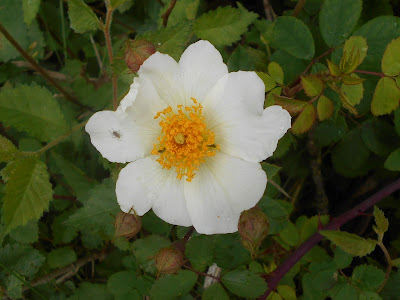Very broad verges surround the fields of crops and the flowers which occupy these areas, though largely 'agricultural weeds'. add colour to the landscape.
 |
The broad borders to the fields support ox-eye daisies, poppies and
hogweed. 15 June, 2019
|
The flowers, such as Ox-eye Daisy, Chrysanthemum leucanthemum, Common Poppy, Papaver rhoeas, and Hogweed, Heracleum sphondylium, were being visited by a wide range of insects, particularly bumblebees. Also present were clumps of Common Mallow, Malva sylvestris.
 |
Common Mallow, a relative of cotton and okra, is worth a close examination.
15 June, 2019
|
Mallow supports several interesting species of weevil and I must make a return visit to check which species are present.
Red Campion is flourishing very well it seems across much of Britain. White Campion is rather less common, particularly around Byfield where the soils are on the acid side, and I was therefore pleased to find both species in numbers beside our track.
 |
| White Campion is very fragrant after nightfall. 15 June, 2019 |
White Campion, Silene alba, produces a heady fragrance as evening approaches, aiming to attract night-flying insects, but I have never noticed this with Red Campion, Silene dioica. Both species have five petalled flowers but the petals are deeply divided and at a glance there sometimes appears to be ten petals.
 |
Red Campion is much the commoner plant hereabouts. Its five petals
can be so deeply divided as to appear to be ten. Farmland south of Byfield.
15 June, 2019
|
Although the two species are closely related, sometimes producing hybrids when they are in proximity, there are some important differences and botanists often place the two in separate genera. White Campion is an annual whereas its congener is a perennial. Both campions bear male and female flowers on separate plants, as indicated in the case of the Red Campion by the epithet 'dioica'.
It was rather surprising to find specimens of what appear to the Field Rose, Rosa arvensis, beside the track. I make no claim to be a rose expert but the Field Rose normally grows on calcareous soils, as distinct from the rather acid land around Byfield. I should have taken a sample for examination later.
 |
Rosa arvensis? Probably, but I have a nagging suspicion...
Farmland south of Byfield. 15 June, 2019
|
The attention given to wildlife conservation was very impressive and I was also pleased to note that a number of thickets of trees have been established on spare ground. It would be churlish to complain that some of the trees were North American because overall they have surely been of benefit to our fauna.
* I confess to a mild irritation with ex-military officers who insist on using their rank after retirement. We do not hear of Fire Chief Wilson, Head Teacher Barnes or Detective Chief Inspector Brown clinging to their rank or status when they have hung up their truncheons or whatever.

No comments:
Post a Comment